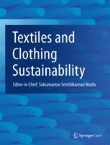Contribution of traceability towards attaining sustainability in the textile sector
Sustainability is a widely recognized concern and priority for healthy growth of the society and for preservation of the planet. Concerning this, textile sector has seen an unprecedented demand for sustainable...
